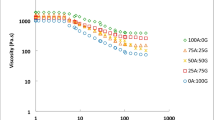Abstract
Rheological behavior of natural hydrogel produced from seeds of threeSalvia spp. (S. miltiorrhiza (SM),S. sclarea (SS), S.viridis (SV)) was investigated by using a Rheometer equipped with a cone and plate geometry measuring system under never-dried condition. Different chemical contents of such hydrogels give significant effects on their rheological properties. Because of incomplete penetration of water inside the hydrogels after drying before-dried hydrogels were used for rheological analysis. To know molecular interactions which predominated in the gel formation, some constituents were externally added to the 1.0% (w/w) hydrogel. Addition of urea to disrupt hydrogen bonds reduced 3.4-67% viscosity of the untreated hydrogels and changed viscoelastic properties from gel to liquid-like behavior. Neutral salts added to the hydrogel solution at 0.1 M also lowered the viscosity in a manner related with increase in size of cations and temperature. Changing from gel state to liquid-like state was also easily confirmed by oscillation measurement (storage,G′, and loss,G′⇔’, modulii) typically observed in the cases of potassium sulfate and potassium thiocyanate. Influence of pH variation on the viscosity explained that weak alkaline condition (pH 8-9) creates a higher resistance to flow due to increasingly electrostatic repulsions between negative charges (COO-). Importance of calcium bridges was also demonstrated by recovery of viscosity of the hydrogels by addition of calcium after acidification. The summarized results indicate that electrostatic repulsion is a major contributor for production of hydrogel structure.
Similar content being viewed by others
References
R. Yudianti, L. Indrarti, M. Sakamoto, and J. Azuma,Proceedings of The 5 th International Wood Science Symposium, pp. 199–204 (2004).
R. Yudianti, L. Indrarti, M. Sakamoto, and J. Azuma,Proceedings of The 6 th International Wood Science Symposium, pp. 273–277 (2005).
R. Yudianti, L. Indrarti, M. Karina, M. Sakamoto, and J. Azuma,Journal of Tropical Wood Science and Technology,5, 12 (2007).
R. Candrasekaran, A. Radha, and V. G. Thailambal,Carbohydr. Res.,224, 1 (1992).
E. Loizou, J. T. Weisser, A. Dundigalla, and G. Schmidt,Macromol. Biosci.,6, 711 (2006).
M. A. Torres, M. M. Beppu, and E. J. Arruda,Brazilian J. Food Technol.,9, 2, 101 (2006).
J. Tang, J. Lelievre, M. A. Tung, and Y. Zeng,J. Food Sci.,59, 1 (1994).
J. Tang, M. A. Tung, and Z. Yanyin,Food Sci. J., 60 (1995).
F. Yamamoto and R. L. Cunha,Carbohydr. Polym.,68, 517 (2007).
Rodriguez-Hernandez, S. Durand, C. Garnier, A. Tecante, and J. L. Doublier,Food Hydrocolloid,17, 621 (2003).
R. Fijan, S. Sostar-Turk, and R. Lapasin,Carbohydr. Polym.,68, 708 (2007).
E. Gregorova, W. Pabst, and J. Stetina,Ceram. Silikaty,50, 232 (2006).
J. Tsai, M. Gerstein, and M. Levitt,J. Chem. Phys.,104, 9417 (1996).
B. S. Kim, I. D. Jung, J. S. Kim, J.-H. Lee, I. Y. Lee, and K. B. Lee,Biotechnol. Lett.,22, 1127 (2000).
D. W. Renn,Carbohydr. Polym.,33, 219 (1997).
J. Cho, M.-C. Heuzey, A. Begin, and P. Carreau,Carbohydr. Polym.,63, 507 (2006).
H. Melina, C. H. Marie, and B. Andre,Hydrogel. Rheology Acta,45, 659 (2006).
H. Yiqun, S. Pawan P., T. Juming, and S. Bary G.,Carbohydr. Polym.,56, 27 (2004).
Author information
Authors and Affiliations
Corresponding author
Rights and permissions
About this article
Cite this article
Yudianti, R., Karina, M., Sakamoto, M. et al. Effects of salts on rheological behaviour of salvia hydrogels. Macromol. Res. 17, 332–338 (2009). https://doi.org/10.1007/BF03218871
Received:
Revised:
Accepted:
Issue Date:
DOI: https://doi.org/10.1007/BF03218871




